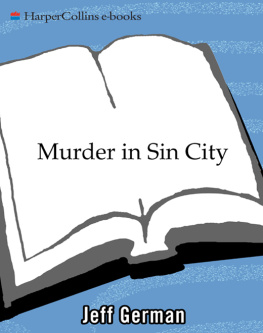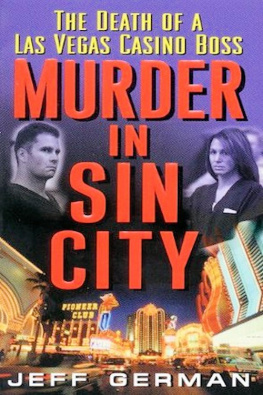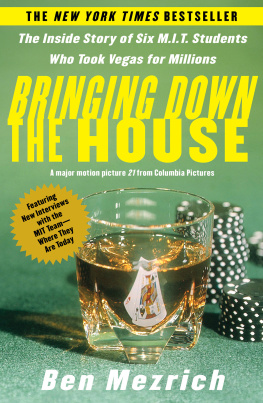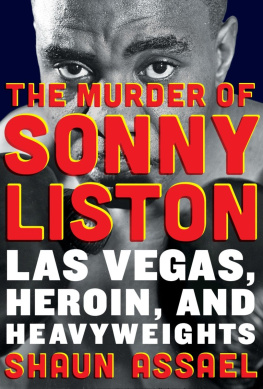T HIS BOOK IS the result of more than three years of covering the troubled life and death of Ted Binion for the Las Vegas Sun. I have written more than 350 stories and columns on the subject and have spent countless additional hours doing research.
The story of Binions demise has been pulled together from newspaper articles, secret and public court transcripts, confidential law enforcement documents and fresh interviews with key players in the homicide investigation.
I was not one of Binions favorite reporters his last months alive. My stories disclosing his underworld ties led to the revocation of his gaming license, his downward spiral in life and, of course, his final betrayal. In the push to bring his killers to justice, I came to know Binion better in death than in life, and I learned to admire his uniqueness as the last of a dying breed of colorful casino bosses.
As with any project of this magnitude, there are many people to thank. I would like to start with my friends at the Las Vegas Sun. I owe a debt of gratitude to Publisher Barbara Greenspun and her astute sons, Brian and Danny Greenspun, for giving me the freedom to pursue this book. The Green-spuns have been like family to me over the years, and I am proud to have had a chance to sharpen my journalistic skills under the tutelage of the legendary Hank Greenspun.
Executive Editor Mike OCallaghan, whom I regard as a second father, was always there for me on this project with the kind of solid advice that only he could give. And Managing Editor Michael J. Kelley, who has become a valued asset to the Las Vegas community in only a few short years, gave me the benefit of his insight and patience as I sometimes struggled to put this book together. Thanks also go out to Metro Editor Warren Johnston, who provided me with much encouragement and motivation. Johnston is what all big-city newspaper editors should strive to be. Photo Editor Marsh Starks was a huge help in assembling most of the pictures for this book that were taken by the newspapers award-winning photographers, Steve Marcus, Lori Cain, Sam Morris, Aaron Mayes and Ethan Miller. And librarian Rebecca Clifford assisted with research. I also wish to thank my fellow reporters at the paper for carrying the load in my absence, as well as office manager Gail Perry and my other editors and copy editors, who Im sure missed my smiling face on many occasions in the morning. Special thanks also to Stacy Willis and Martin Kuz for their well-done profiles of Sandy Murphy and Rick Tabish. Those stories were very helpful.
There are many people outside the Las Vegas Sun who deserve thanks, too.
I never really had a chance to get acquainted with Bonnie Binion, but I want to thank her for handling the tragedy of her fathers death with grace and dignity. Youll see excerpts here later from a moving letter Bonnie wrote expressing sorrow over losing her father. I didnt come across the letter until the book was nearly completed, but it gave me comfortas Im sure it will give othersin dealing with the loss of a cherished parent.
Thanks also go out to Becky Behnen, who gave me the benefit of her keen sense of perception on a regular basis. Becky always was there to answer my questions. More than anyone, she was responsible for lighting a fire under investigators to uncover the truth about her brothers death. I also owe much gratitude to David Roger, who with this case has become one of the premier prosecutors in Las Vegas and probably the nation. I could not have written this book without his wisdom and assistance.
Tom Dillard earned a much-deserved reputation as the citys top private investigator during this case. Thank you, Tom, for putting up with my phone calls for more than two years. One of the many unsung heroes of this case was homicide detective James Buczek, who is as professional and dedicated as they come. Buczek was a tremendous help. So were David Wall, Wayne Petersen, James J. Brown, Richard Wright, Harry Claiborne, Joseph Bonaventure, Al Lasso, Nick Behnen, Stewart Bell, Bill Koot, Ron Flud and Bob Stoldal.
There were many others who provided me with inside information on both sides of this case, but wished to remain anonymous. Thanks to you, as well. You know who you are.
These acknowledgments would not be complete without expressing appreciation to Sarah Durand, a first-rate editor who made this first-time experience enjoyable for me.
I also wish to thank my group of close friendsamong them Art Nadler, Frank Fertado, George McCabe, Rob Powers and Will Kempwho put up with me for months while I was busy writing. Over drinks and coffee, they kept my spirits high and, once in a while, gave me good advice. I also had many consoling conversations with my brother-in-law Mike Smith, the Sun s award-winning cartoonist.
My family members were especially supportive and understanding. I wasnt always there for them when they needed me during a difficult family time. Thanks to my father, Max German, sisters Julie Smith and Jill Zwerg, brother Jay German, and my other brother-in-law Fredric Zwerg. I love you all.
Finally, I wish to thank my mother, June German, who like many Las Vegans was enthralled with this story. Mom never missed reading one of my articles. She was my inspiration, always believing, even when I had my doubts, that I was capable of writing this book. She passed away six weeks before I signed my book deal and never got a chance to see the trial. You will always be in my heart, Mom. This is for you.
S TEVEN R EINCKE, a veteran fire department paramedic, and his crew were the first to arrive at Ted Binions posh ranch-style home in Las Vegas about 3:57 P . M . on September 17,1998.
As they hurried past the opened steel security gates, they ran into Sandy Murphy, the wealthy gambling figures beautiful twenty-six-year-old girlfriend, sobbing on the steps of the front door. Minutes earlier, the frantic former topless dancer had telephoned police to report that her husband had stopped breathing.
Hysterical and screaming, Murphy led the paramedics inside. They rushed along the white marble floors of the spacious sunken living room and passed the dining room on the right to Binions den, his favorite place in the 8,000-square-foot home, where they found his lifeless body on a blue sleeping mat in the middle of the moth-colored carpeted floor. Clad only in a half-buttoned long-sleeve shirt and Calvin Klein briefs, the fifty-five-year-old Binions arms were at his sides and his legs were straight and covered with a quilt. He was lying alongside his favorite piece of furniture, a plum-colored sofa that was worn out and spattered with cigarette burns on its left side, where Binion had often smoked and watched television on his thirty-two-inch console across the modest-sized room. Next to his body were a pair of black jeans, some loafers, three disposable lighters, an opened package of Vantage cigarettes, a television remote control and, most intriguing of all, an empty bottle of the prescription sedative Xanax that the former casino executive had obtained a day earlier. Binion, the second son of the late gaming pioneer Benny Binion, who founded the downtown Horseshoe Club, one of the most popular gambling joints in Las Vegas, was known to take Xanax to ease himself off heroin, a drug he had been addicted to for years.












